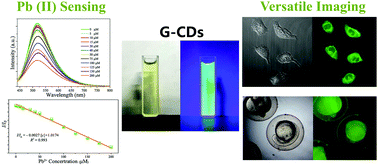Pb(ii) detection and versatile bio-imaging of green-emitting carbon dots with excellent stability and bright fluorescence†
Abstract
Green-emitting carbon dots (G-CDs) were synthesized via a simple and green hydrothermal method using betaine hydrochloride and sulfadiazine as carbon and nitrogen sources, respectively. Excellent luminescence stability with varying pH, salt concentrations, temperature is found with excitation-independent emission. G-CDs can be successfully used for the detection of Pb(II) in the range of 0–200 μM. There was good linear relationship between the Pb(II) concentration and G-CD fluorescence intensity with a correlation coefficient of 0.993, and the limit of detection (LOD) was 3.0174 μmol L−1. Due to its good biocompatibility, G-CDs can be successfully applied to zebrafish imaging as well as cell imaging, and the results show that G-CDs is more suitable for the zebrafish embryo imaging. Our results suggested that the obtained G-CDs can be used as multifunctional probes, highlighting their potential in different biological studies.



 Please wait while we load your content...
Please wait while we load your content...